Palm - California Fan
Abundance: uncommon
What: fruit, seeds, palm heart,
How: fruit raw, dried, cooked, jelly; seeds ground up then boiled; palm heart roasted or pickled
Where: landscaping, dry areas
When: Spring, Summer, Fall
Nutritional Value:
Dangers:
This is a native palm and was utilized by Native Americans. Fruit is blue-black, pea-sized and eaten raw, dried, cooked, or made into jellies. Fruit and seed are dried, ground up, then boiled as porridge. Edible heart (central, youngest leaf bud) is roasted though harvesting the heart kills the palm. Leaf fibers used as cordage.
Buy my book! Outdoor Adventure Guides Foraging covers 70 of North America's tastiest and easy to find wild edibles shown with the same big pictures as here on the Foraging Texas website.
Palm - Canary Island Date
Abundance: uncommon
What: fruit, flowers, sap
How: fruit raw, dried, cooked; flowers raw; sap straight, fermented, or evaporated to syrup or sugar
Where: landscaping
When: fall
Nutritional Value: calories
Canary Island date palm.
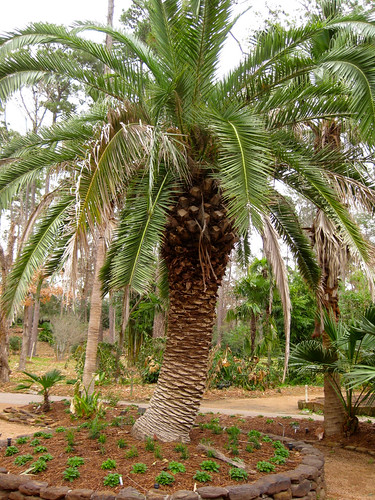
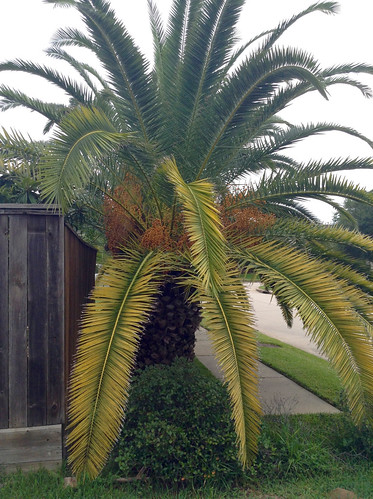
Canary Island date palm base.
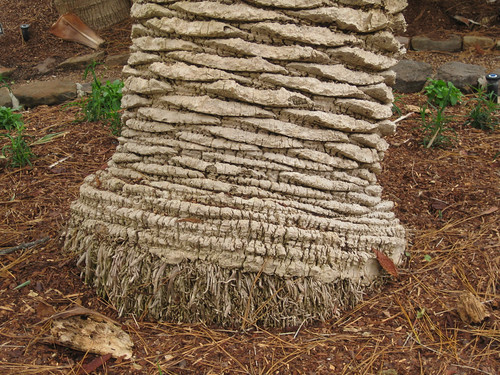
Canary Island date palm trunk.

Trunk with almost-mature fruit.

Canary Island date palm crown.
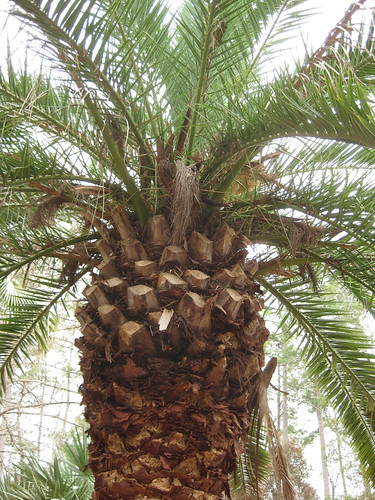
Canary Island date palm needle-type leaf. Note the alternating pattern.
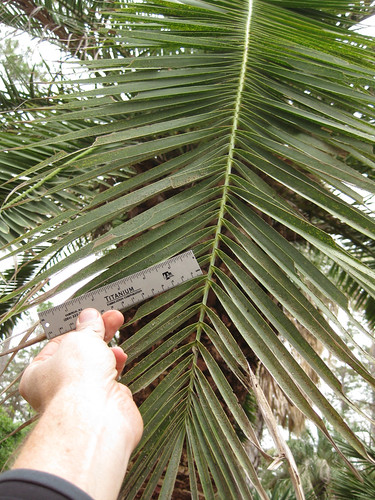
Almost ripe fruit.
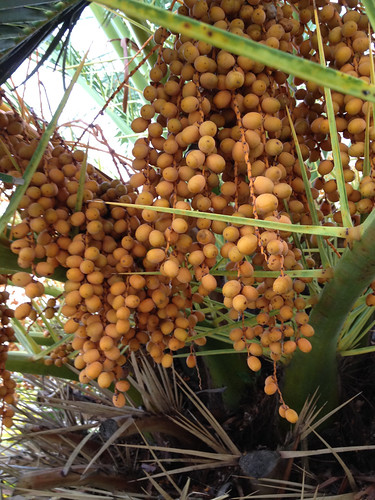
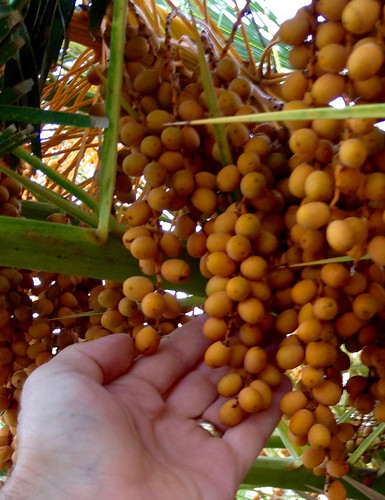
These palms usually remain short and squat for ten years or more before growing taller to their final height of thirty to sixty feet. The leaves are long like those of the Queen palm rather than fan-shaped.
Fall is when the fruit appear on clusters of long strands. They are yellow-orange oval, 3/4" long, flesh is sweet but very thin over a large seed making it undesirable as snacking date. The preferred utilization of these dates is conversion to jelly...or wine! Woohoo!
A good palm oil can be pressed from its seeds using a nut press.
The sap is very sweet and can be drank as is, fermented into palm wine, or evaporated down to palm syrup or sugar. Traditionally it is collected by carefully carving a bowl-shaped depression in the tree's crown in the late afternoon or evening. The sap collects in this depression overnight and is gathered in the morning. If left exposed to sun and air it will quickly spoil. Please note, carving out the crown of the tree in this manner will likely result in the palm dying. There has been some luck/non-tree death with cutting the young fruit stalks (inflorescence spadix) in early summer and collecting the sap from them.
Buy my book! Outdoor Adventure Guides Foraging covers 70 of North America's tastiest and easy to find wild edibles shown with the same big pictures as here on the Foraging Texas website.
Palm - Date
Abundance: rare
What: fruit, flowers, sap, terminal bud (palm heart)
How: fruit raw, dried, cooked; flowers raw; sap straight, fermented, or boiled down to syrup or sugar, terminal bud roasted or pickled.
Where: landscaping
When: flowers in spring, fruit in summer, sap anytime except winter
Nutritional Value: fruit - calories, vitamin C, minerals
Date palm.
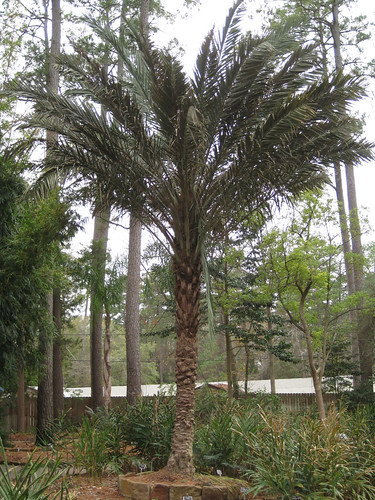
Date palm base.

Date palm trunk.
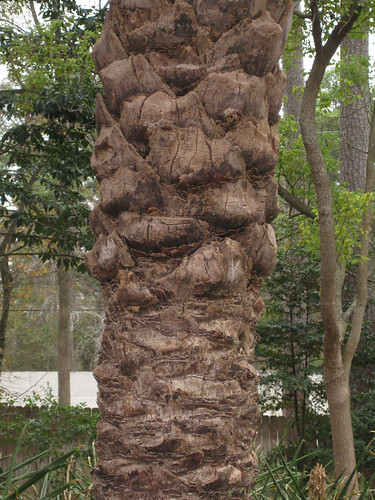
Date palm crown. Needle-type leaf.
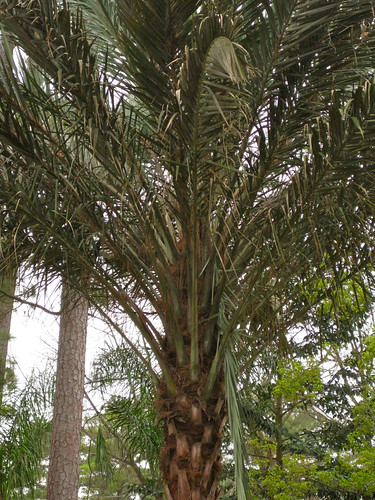
Dates from Phoenix dactylifera are considered to be the sweetest of palm fruit. Originally from the Middle East, these trees are now found along the Gulf Coast as well as California. They require a lot of water but don't do well in areas of high humidity like Houston and dates from trees in this area are usually of low quality. Trees are either male or female with the females being the only ones to produce dates after wind fertilization from a nearby male tree's pollen.
The sap is very sweet and can be drank as is, fermented into palm wine, or evaporated down to palm syrup or sugar. Traditionally it is collected by carefully carving a bowl-shaped depression in the tree's crown in the late afternoon or evening. The sap collects in this depression overnight and is gathered in the morning. If left exposed to sun and air it will quickly spoil.
Date palm flowers appear in the spring and are eaten raw. Palm hearts (terminal buds) are the "root" the center-most, youngest leaf at the very top of the tree. It is harvested by cutting off the top of the tree and carving out the palm heart which kills the tree.
Buy my book! Outdoor Adventure Guides Foraging covers 70 of North America's tastiest and easy to find wild edibles shown with the same big pictures as here on the Foraging Texas website.
Palm - Dwarf Palmetto
Abundance: plentiful
What: The "heart" of the plant, fruit
How: Raw, cooked
Where: Shady, moist, low areas
When: Buds all year, fruit late summer to mid-fall
Nutritional Value: rich source of carbohydrates
Other uses: Fibers/cordage
Dangers: very pointy leaves
Dwarf palmetto plant.
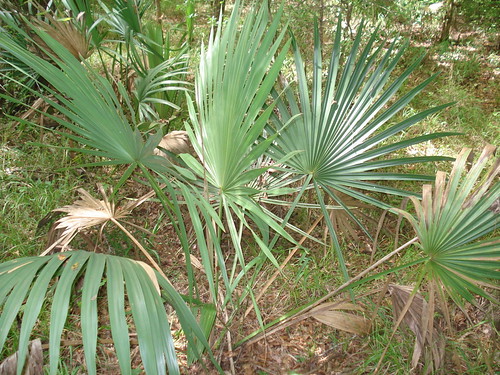
Stand of Dwarf Palmettos.
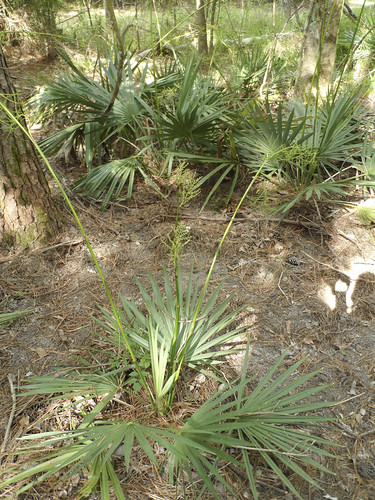
Dwarf palmetto flowering in July in the Houston area.
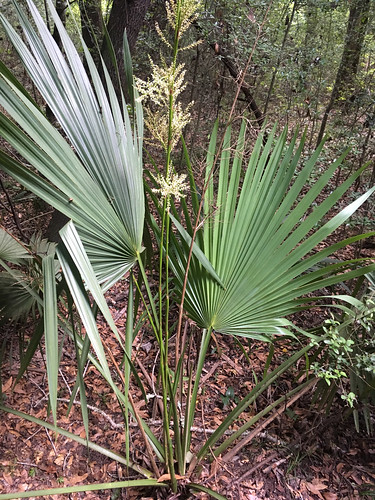
Close-up view of the dwarf palmetto flowers.
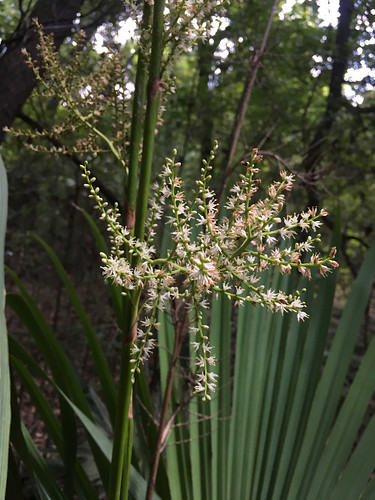
Still closer view of the flowers.
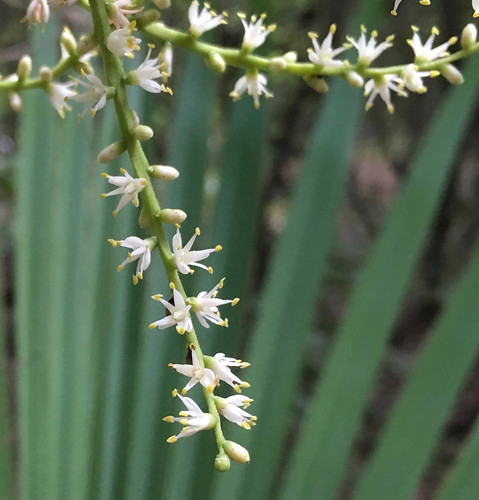
Fruit (edible when flat black in color).
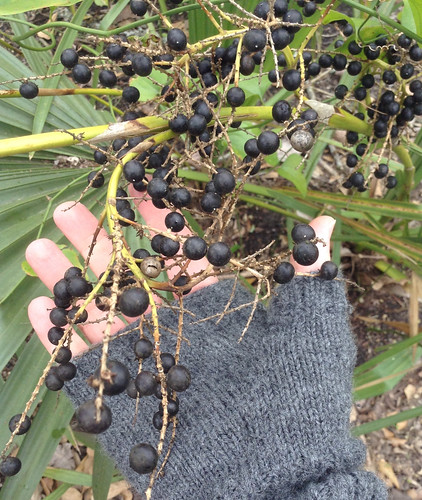
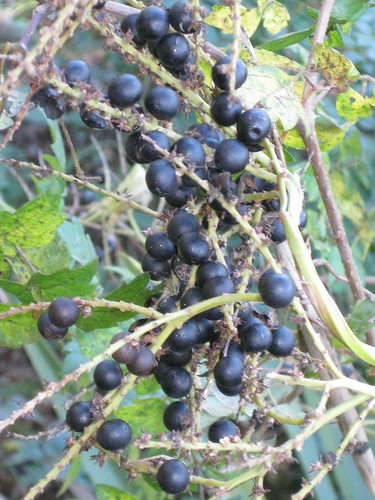
Underground portion of root system exposed along river bank.

Root section dug up and peeled to reach terminal bud and heart.

Texas distribution, attributed to U. S. Department of Agriculture. The marked counties are guidelines only. Plants may appear in other counties, especially if used in landscaping.
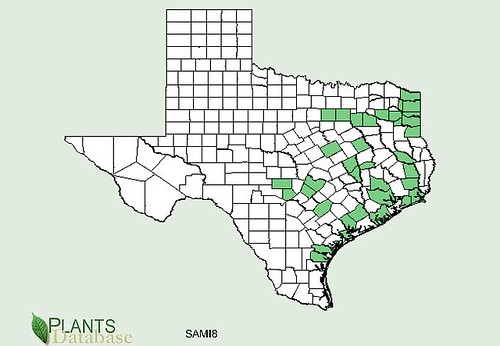
North American distribution, attributed to U. S. Department of Agriculture.
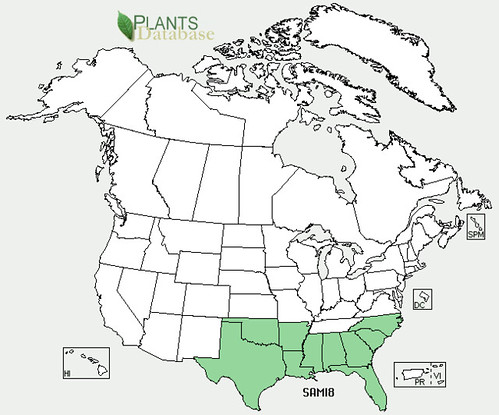
Dwarf palmettos are good sources of calories all year. The easiest way to get the "heart" of this palm is to dig up, root ball and all, then peel/cut away the fronds. Eventually you'll reach an inner section that looks like the inner portions of celery or an artichoke heart. Cut away the roots and anything still stiff or hard. Anything soft is edible. It has a somewhat bitter, unusual taste raw. Roasting it makes it a little sweeter.
The berries begin appearing in late summer and are usually edible into mid-fall in the fall. They are very nutritious and supposedly are good for the prostrate. A word of warning though. These berries taste really good to about 85% of the population. 15% of humans have an extra taste receptor that can sense a particular chemical in these berries that the other 85% can't. I have those extra taste sensors and to me the fruit tastes the way cat vomit smells. Most likely they'll taste good to you.
The berries have a larger kernel from which palm oil can be pressed. You can find ready-made nut oil presses on line as well as directions on how to make your own oil press out of some pieces of pipe and an auger bit.
Dwarf palmettos grow in low, wet, shady areas. If you are looking to buy property and dwarf palmettos are present you can be pretty sure that area floods often!
Buy my book! Outdoor Adventure Guides Foraging covers 70 of North America's tastiest and easy to find wild edibles shown with the same big pictures as here on the Foraging Texas website.
Palm - Mexican Fan
Abundance: uncommon
What: fruit
How: raw, dried
Where: landscaping, wild along Gulf Coast.
When:
Nutritional Value:
Dangers:
Fan-shaped fronds have spiny stalks. Fruit is blue-black, pea-sized, sweet with a large, inedible seed.
Buy my book! Outdoor Adventure Guides Foraging covers 70 of North America's tastiest and easy to find wild edibles shown with the same big pictures as here on the Foraging Texas website.
Palm - Pindo, Jelly
Abundance: common
What: fruit
How: raw, jelly, wine
Where: landscaping, Gulf Coast region
When:
Nutritional Value:
Dangers: none
Pindo palm.
Nearly-ripe pindo palm fruit (turns yellow/gold when ripe).
Pindo palm crown and needle-type leaves.

Closeup of a pindo palm leaf. They have a gray/blue tint.
Pindo palms are short, squat trees with long, gray/blue-green fronds. Pindo palm fruit appears in the summer and is yellowish-orange, about the size of figs. They taste great but it's large, inedible seed and stringy flesh makes eating it raw a challenge. The preferred method of eating Pindo palm fruit is as jelly hence it's common name, "Jelly Palm". Pindo palm fruit naturally contains pectin but only barely enough to jellify and it is recommended that extra pectin be added. Also, the seeds must be removed before cooking the fruit down or something in them will interfere with jellification.
This fruit has also been used to make wine though if you don't destroy the natural pectin with some pectinase the wine will end up cloudy.
A good quality palm oil can be pressed from the fruit's large seed. If you don't have an oil press try grinding up the fruit in a blend then boil it. The oil will float to the top of the water and can be skimmed off once the water cools down.
These palms usually remain as short, squat trees. At one time they were a prized possession as the fruit was plentiful, delicious, and used many ways. Nowadays they are often considered to be a nuisance, messy tree. How crazy is that?!
Buy my book! Outdoor Adventure Guides Foraging covers 70 of North America's tastiest and easy to find wild edibles shown with the same big pictures as here on the Foraging Texas website.
Palm - Queen
What: fruit
How: raw, jelly
Where: landscaping, Gulf Coast region
When:
Queen palm.
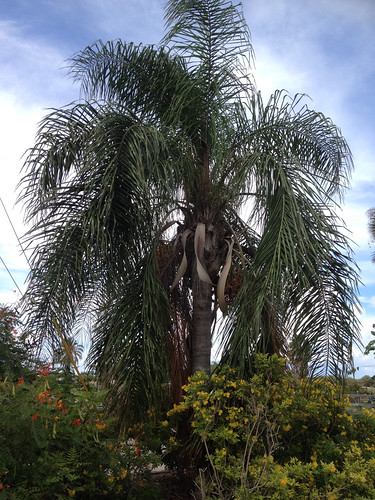

Queen palm base.

Queen palm trunk.

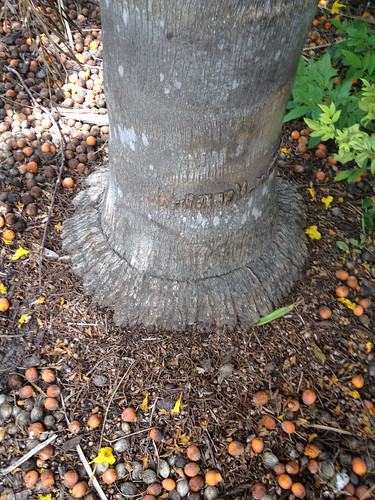
Queen palm crown. Needle-type leaves.
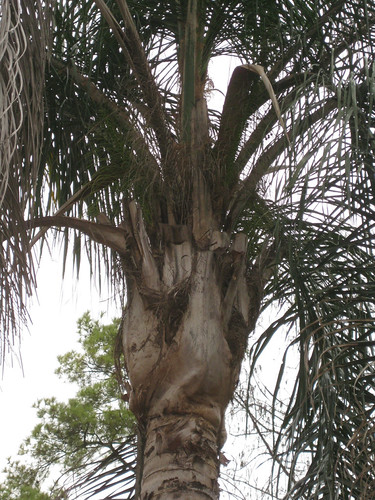
The orange fruit appear in late summer/early fall.
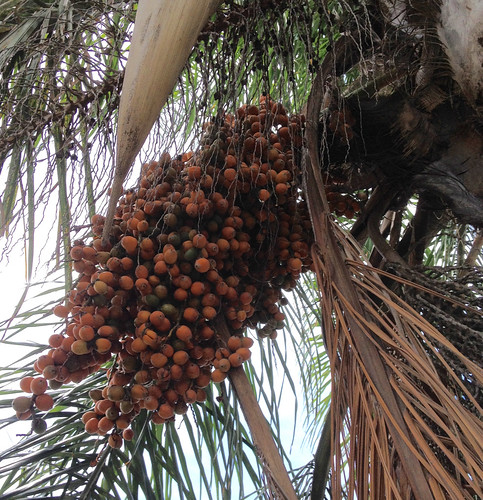
Close-up of the fruit. You can see the fibers nature in the older, brown/gray fruit.
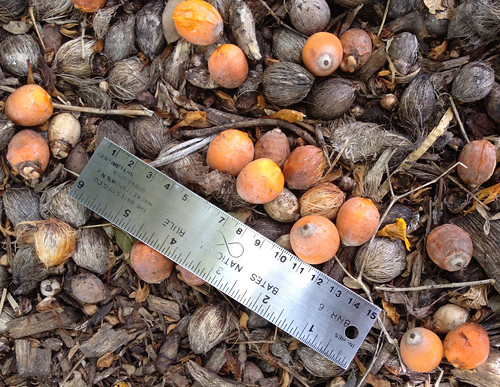
Standing majestically, Queen palms live up to their names and so are often used as a landscaping palms. Their trunk is rather smooth and gray. Its leaves can be up to fifteen feet in length. The individual fronds are somewhat stiff. If you want to add one to your yard they prefer acidic, moist soil and are somewhat salt-tolerant if you are near the coast.
In the late summer/fall appear large clusters up to six feet long of orange, one inch fruit. The flesh of this fruit is sweet but fiberous. Just chew/suck the sweetness from the fruit and then spit out the fibers. Like the Pindo palm, these sweet fruit can also be used to make jelly or wine. A good quality palm nut oil can be extracted from the seeds though some sort of oil press is recommended for this.
The fruit is often 20' or more feet off the ground which makes harvesting tricky. Laying a tarp down beneath the tree and then either shake the tree (difficult) or toss a Nerf ball the clusters to dislodge the fruit. A Nerf ball is hard enough to dislodge the fruit but soft enough to not damage them.
Buy my book! Outdoor Adventure Guides Foraging covers 70 of North America's tastiest and easy to find wild edibles shown with the same big pictures as here on the Foraging Texas website.
Palm - Texas Sabal
Abundance: common
What: fruit, palm heart
How: fruit raw; palm heart roasted, pickled
Where: landscaping, wild from southern to central Texas
When: summer, fall, spring
Nutritional Value:
Dangers: none
Texas sabal palm.
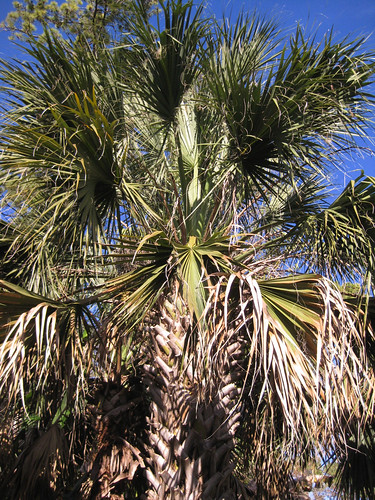

Texas sabal palm base.

Texas sabal palm trunk and crown.
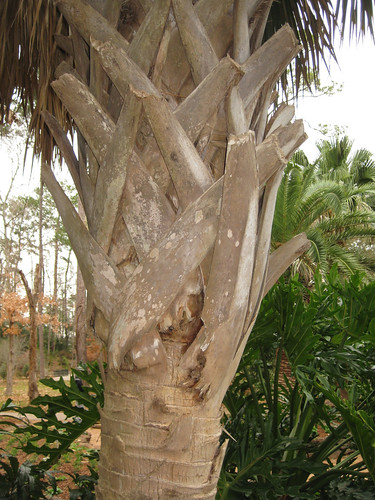
Texas sabal palm fan-type leaves.
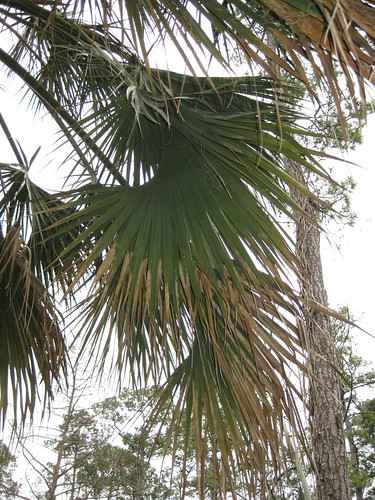
Fruit dark purple, .5” in diameter, thinly fleshed over a large seed, ripens in summer.
The palm heart is also eaten, but harvesting it kills the palm. Palm hearts (terminal buds) are the "root" the center-most, youngest leaf at the very top of the tree. It is harvested by cutting off the top of the tree and carving out the palm heart which kills the tree.
Leaf fibers make great cordage.
Buy my book! Outdoor Adventure Guides Foraging covers 70 of North America's tastiest and easy to find wild edibles shown with the same big pictures as here on the Foraging Texas website.
Palm - Windmill
Abundance: common
What: flower buds and flowers (inflorescences)
How: raw or cooked
Where: landscaping
When: spring
Nutritional Value:
Dangers:
Windmill palm.
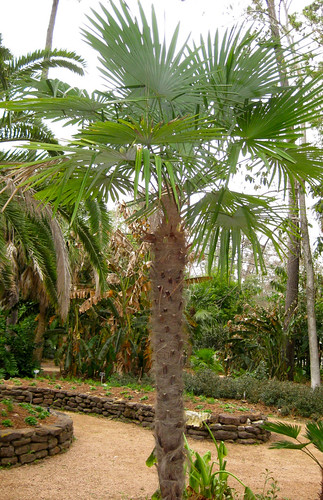
Windmill palm base.
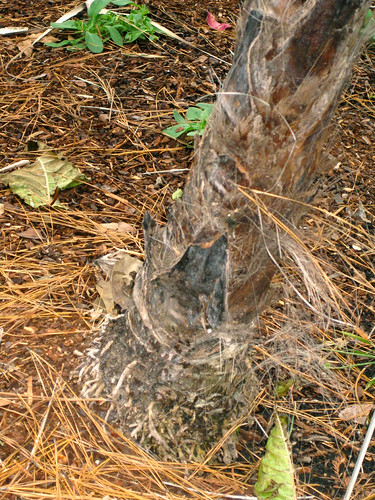
Windmill palm trunk.
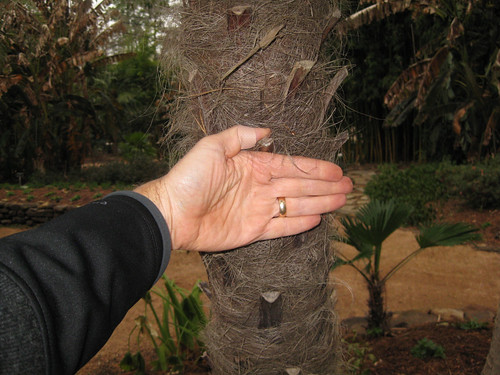
Windmill palm fan-type leaf.
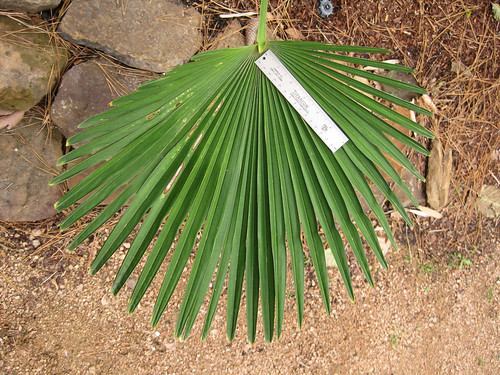
Native to China, this palm actually prefers cold climates and doesn't do well in hot, humid areas such as the Gulf Coast region. The leaf fibers make an excellent cordage.
The flower buds and flower bodies are eaten raw though I bet they could be candied, too.
Fruit ranges in color from yellow to black.
Buy my book! Outdoor Adventure Guides Foraging covers 70 of North America's tastiest and easy to find wild edibles shown with the same big pictures as here on the Foraging Texas website.
Privacy & Amazon Paid Promotion Statement
I use third-party advertising companies to serve ads when you visit this website. These companies may use information (not including your name, address, email address, or telephone number) about your visits to this and other websites in order to provide advertisements about goods and services of interest to you. If you would like more information about this practice and to know your choices about not having this information used by these companies, click here.
I participate in the Amazon Services LLC Associates Program, an affiliate advertising program designed to provide a means for me to earn fees by linking to Amazon.com and affiliated sites. The prices you pay for the item isn't affected, my sales commission comes out of Amazon's pocket.
*These statements have not been evaluated by the Food and Drug Administration. This product is not intended to diagnose, treat, cure, or prevent any disease.




